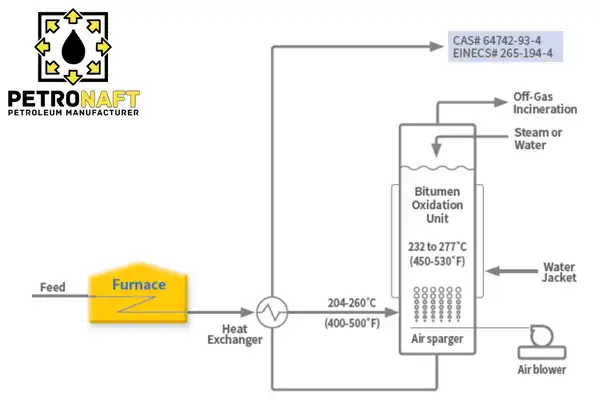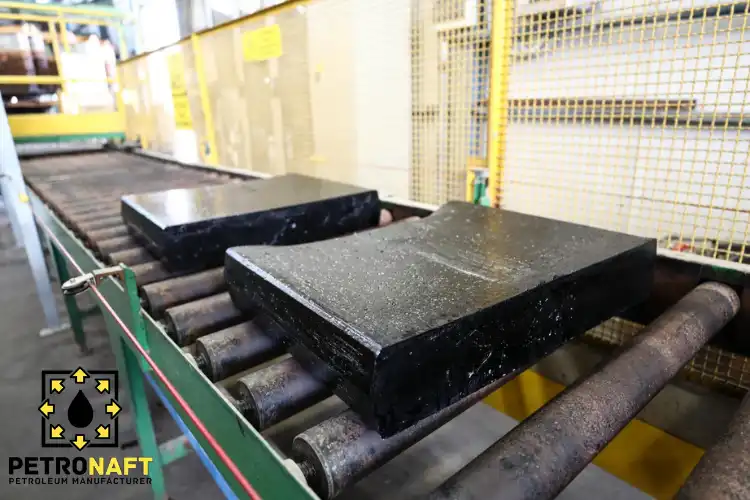Oxidized (Blown) Bitumen Production is made by reacting hot bitumen with controlled air in a reactor, raising softening point and viscosity while reducing penetration. The result is a tougher, more heat-stable binder used in roofing, waterproofing, pipe coating, and industrial insulation. Final grade is tuned by air rate, temperature, and blowing time.
Oxidized (blown) bitumen sits between “standard paving binders” and “specialty industrial binders.” If you’re here to buy, specify, or troubleshoot, focus on:
Grade format (softening point / penetration)
Consistency (QC tests + COA)
Fit-for-use (roofing vs. coating vs. mastics)
Highlights & Key Sections
What Oxidized Bitumen Really Changes Inside the Binder
When bitumen is “blown,” it doesn’t just get thicker—it becomes more structured.
In practical terms, oxidation typically:
Increases softening point (better high-temperature stability)
Lowers penetration (harder binder at 25°C)
Raises viscosity (better body for membranes/coatings)
Improves resistance to flow on hot surfaces (key for roofing and waterproofing)
Think of it as shifting the binder from “traffic-grade flexibility” toward “industrial stability” for standing, sealing, and protecting.
Oxidized (Blown) Bitumen Production: How the Process Works
Most plants follow the same logic: heat → blow air → control reaction → hit grade → stabilize → package.
Typical process flow (operator-level view)
1) Feed preparation
Select suitable feedstock (often heavy residues).
Heat to a controlled processing window (hot enough for reaction, not so hot you risk runaway oxidation).
2) Air blowing in a reactor
Dry air is injected through spargers/distributors.
Reaction is exothermic, so temperature control is not optional.
3) Property tracking
Samples are taken to track softening point and penetration.
When the curve reaches target, air is reduced/stopped.
4) Finishing
Product is “settled” or stabilized to reduce foaming/entrained air.
Then it’s filtered (as needed) and packaged.
Batch vs. continuous (what buyers should know)
| Mode | What it’s good at | Common trade-off |
|---|---|---|
| Batch blowing | Tight control for specialty grades | Slower, more sampling time |
| Continuous | High volume, steady output | Needs strong automation/QC discipline |
Key Variables That Decide the Final Grade
If you’ve ever wondered why two suppliers can both sell “115/15” but performance feels different, it usually comes down to feedstock + process window + finishing discipline.
| Variable | If you increase it… | What you’ll typically see |
|---|---|---|
| Temperature | Reaction speeds up | Faster hardening; higher risk of over-blowing if uncontrolled |
| Air rate | More oxidation per time | Penetration drops quicker; foaming and fume load can rise |
| Residence time | Longer oxidation | Higher softening point; lower penetration (until you overshoot) |
| Feedstock chemistry | More “reactive fractions” | Easier to reach grade; final aging behavior may differ |
| Additives/catalyst (if used) | Reaction accelerates | Tighter control required; can change long-term behavior |
Hands-on tip: In production, operators often track a simple “grade trajectory”:
If penetration drops too fast relative to softening point, the product can become brittle for some uses.
If softening point rises slowly, you may need a different process window (or feed blend), not just more time.
Grades Explained: How to Read 75/25, 90/15, 115/15
Most oxidized grades are expressed as:
Softening point (°C) / Penetration (0.1 mm at 25°C)
A quick mental model:
Higher first number = better heat stability
Lower second number = harder binder
Common grades and where they fit best
| Typical grade | What it feels like in use | Best-fit applications | Practical note |
|---|---|---|---|
| 75/25 | Workable, good body | General waterproofing, mastics | Good balance when you need spreadability |
| 85/25 | More heat-stable | Waterproofing membranes, industrial mastics | Often chosen for warmer climates |
| 90/15 | Harder, stronger film | Roofing, pipe coating base layers | Better flow resistance on hot surfaces |
| 105/15 | High heat stability | Premium roofing & heavy-duty coatings | Needs careful application temperature control |
| 115/15 | Very heat-stable | High-performance membranes/coatings | Great stability; confirm flexibility needs |
| 150/5 | Extremely hard | Specialty insulation, industrial sealing | Usually not for flexible membranes |
Mini Tutorial: Pick the Right Grade in 5 Steps
Use this when you’re specifying for a project (or comparing supplier offers).
Define the surface temperature reality
Roof surfaces can run far above ambient in direct sun.
Pipes and tanks may see steady thermal loads from process heat.
Choose performance priority
Roofing: flow resistance + durability
Waterproofing below-grade: adhesion + stability
Pipe coating: corrosion protection + mechanical integrity
Mastics: workability + sag resistance
Set a softening point target
Higher temperature exposure → higher softening point grade.
Check penetration against flexibility needs
Too low penetration can mean brittleness in cold or movement-heavy areas.
Confirm application method
Torch/heat application, mop application, spray systems, or blending into compounds all change the “best grade.”
Real-world example:
A contractor applying membrane in a hot coastal climate often shifts from a mid-range grade to a higher-softening grade to reduce “creep” and edge flow on parapets—then adjusts installation temperature to keep laydown smooth.
Where Oxidized Bitumen Wins: Uses by Industry
Oxidized bitumen is popular because it builds a thick, stable, protective layer with strong water resistance.
High-impact use cases
Roofing & membranes
Base for waterproofing sheets, felts, and coating compounds
Waterproofing systems
Foundations, terraces, retaining walls, wet areas
Pipe coating & corrosion protection
External protective layers, especially where mechanical durability matters
Industrial mastics and sealants
Expansion joints, patching compounds, damp-proofing
Electrical/industrial insulation
Selected grades used in insulation and specialty sealing
Quick “use vs. property” map
| Use | What matters most | What to prioritize on COA/QC |
|---|---|---|
| Roofing | Heat stability, flow resistance | Softening point, penetration, aging stability |
| Below-grade waterproofing | Adhesion, stability | Penetration balance, softening point, loss on heating |
| Pipe coating | Film integrity, protection | Softening point, ductility/flex behavior, consistency |
| Mastics | Workability, sag control | Viscosity feel, penetration, application temperature window |
Quality Control: What to Test (and What Buyers Should Demand)
A strong COA is more than two numbers. For industrial users, consistency saves money.
Core tests (buyer-friendly explanation)
| Test | What it tells you | Red flag to watch |
|---|---|---|
| Softening point | Heat stability and flow resistance | Big batch-to-batch swings |
| Penetration (25°C) | Hardness/consistency | Too low for flexible uses; too high for hot roofs |
| Ductility / flexibility indicator | Crack resistance tendency | Sudden drop suggests over-blowing or poor feed consistency |
| Flash point | Handling safety margin | Low flash point = handling and process risk |
| Solubility / purity indicator | Clean binder quality | Abnormal insolubles can signal contamination |
| Loss on heating (aging) | Short-term durability signal | High loss can mean early embrittlement |
Procurement tip: Ask for batch consistency data (not only a single COA). A supplier who can show tight variance over recent lots usually runs better controls.
Buying and Specifying: Practical, Commercial Checks
If you’re buying oxidized bitumen for production (membranes, coatings, mastics), these checks prevent expensive rework.
What to request from a supplier
COA with at least softening point + penetration + aging indicator
SDS and handling guidance (especially for hot application)
Packaging options and load plan (drums, cartons, bulk)
Recommended storage temperature and max storage duration
Confirmation of grade stability across shipment lots
Packaging and handling basics
| Packaging | Why it’s chosen | Watch-outs |
|---|---|---|
| Drums | Easy handling, common for exports | Heat management during unloading |
| Cartons/blocks | Clean for factories, easier dosing | Storage heat can soften cartons if mishandled |
| Bulk | Best cost per ton at scale | Needs heated tanks, pumps, and disciplined temperature control |

Operational Risks (and How Good Plants Control Them)
Blowing is a controlled oxidation reaction—so discipline matters.
Common operational risks include:
Foaming/overflow from water contamination or aggressive air rate
Runaway temperature rise because oxidation is exothermic
High fumes/off-gas load if ventilation and capture aren’t engineered correctly
Off-spec product from poor sampling cadence or unstable feed blending
Plant-side controls typically include:
Tight temperature loops (heating + cooling capacity)
Air rate ramping instead of “full blast”
Defoaming strategy and feed dryness control
Off-gas treatment and fume capture systems
Automated sampling triggers and trend charts for grade trajectory
Trends and Innovations Shaping Oxidized Bitumen
Two practical trends are affecting buyers and producers right now:
Lower-emission, cleaner production
More enclosed systems, improved fume capture, and better off-gas handling to meet stricter site and community expectations.
Smarter consistency control
Plants are leaning on automation, inline monitoring, and tighter blending discipline to deliver more repeatable grades—especially for membrane manufacturers who need stable processing windows.
Executive Summary Checklist
Use this as a final “do we have it covered?” list.
Defined the application: roofing, waterproofing, coating, mastic, insulation
Picked grade by softening point + penetration, not by name alone
Confirmed climate/temperature exposure and movement/flex needs
Verified COA beyond two numbers (aging + safety indicators)
Checked batch consistency and packaging suitability
Validated storage and application temperature window
Ensured safety handling plan for hot material and fumes
Confirmed the specification matches your manufacturing method
Conclusion: When you control feedstock quality, reaction window, and QC discipline, Oxidized (Blown) Bitumen Production delivers highly consistent grades that outperform standard binders in roofing, waterproofing, coatings, and industrial protection—especially where heat stability and long service life matter most.
FAQs
1) Is oxidized (blown) bitumen the same as paving bitumen?
No. Paving grades are designed for traffic fatigue and flexibility, while oxidized bitumen is processed to increase heat stability and stiffness for roofing, waterproofing, and industrial coatings.
2) What do the grade numbers like 115/15 mean?
They typically indicate softening point (about 115°C) and penetration at 25°C (about 15 dmm). Higher softening point improves heat resistance; lower penetration means a harder binder.
3) Why can the same grade behave differently between suppliers?
Feedstock chemistry and process control strongly affect internal structure. Two products can meet the same softening/penetration targets but differ in aging behavior, workability window, or flexibility.
4) What’s the most common reason for foaming during blowing?
Water or volatile contamination in the feed is a frequent trigger, especially when air rate is aggressive. Good plants manage feed dryness, ramp air carefully, and use controlled stabilization.
5) How should oxidized bitumen be stored to keep quality stable?
Store in clean, heated systems or well-managed packaging away from extreme heat. Avoid overheating for long periods, and follow controlled heating during unloading to prevent localized degradation.
Sources
Industry test methods and specifications for asphalt/bitumen binders used across global supply chains: ASTM International
European standardization framework widely used for oxidized bitumen specification and conformity: CEN (European Committee for Standardization)
Occupational exposure and industrial hygiene references relevant to hot bitumen processes: NIOSH (CDC)
Authoritative technical publishing platform that includes major civil/materials references (including bitumen handbooks and related engineering texts): ICE Virtual Library

